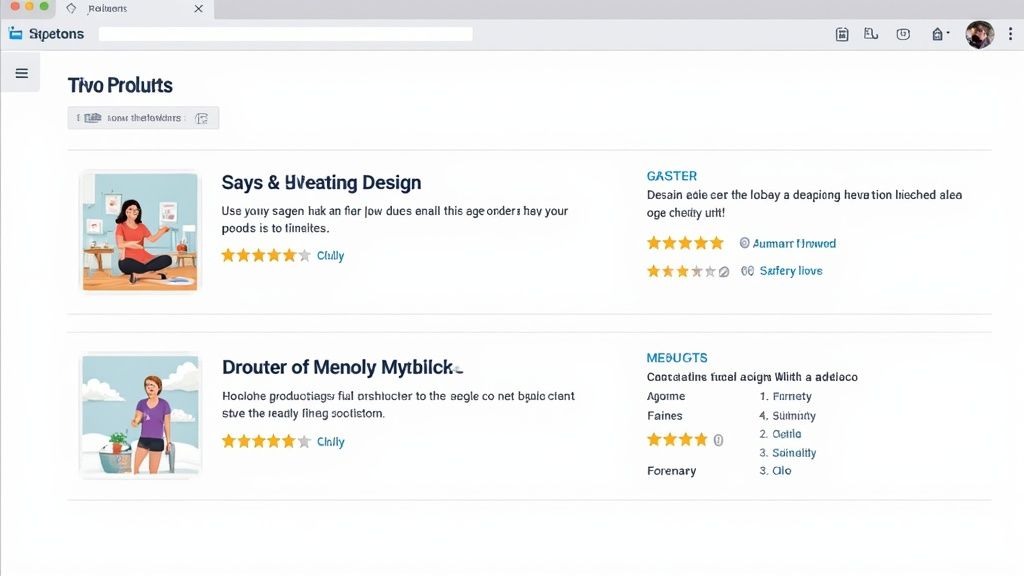Getting Started with Amazon FBA

Selling on Amazon can be a lucrative venture, and one of the most popular avenues is through their Fulfillment by Amazon (FBA) program. This service essentially outsources the logistical headaches of e-commerce, allowing you to tap into Amazon’s impressive infrastructure. This means Amazon handles the storage, packing, and shipping of your products, freeing you to concentrate on other vital aspects of your business. But how exactly do you begin with FBA? Let’s explore the process.
Understanding the FBA Model
Imagine a vast, highly efficient network designed to seamlessly get products from point A to point B. That’s Amazon’s warehouse network, and with FBA, you become a part of it. You send your inventory to Amazon’s fulfillment centers, where it’s stored until a customer places an order. Then, Amazon’s system takes over, picking, packing, and shipping the product directly to the customer. Furthermore, Amazon handles customer service and returns, simplifying the process even more. As of 2024, 82% of Amazon sellers utilize FBA, showcasing its effectiveness in boosting sales and improving customer satisfaction. This widespread adoption speaks volumes about the program’s benefits.
Basic Requirements for FBA
While getting started with FBA involves several key steps, the process is relatively straightforward. First and foremost, you’ll need an active Amazon seller account, which serves as your portal to the Amazon marketplace. This account allows you to list products and manage your sales activities. Next, product selection is critical. Thorough research is vital at this stage, as choosing the right products significantly impacts your profitability. For instance, understanding market demand and pinpointing profitable niches can increase your success. Once you’ve identified your products, prepare them for shipment to Amazon’s fulfillment centers, adhering to their specific packaging and labeling guidelines. Finally, ship your inventory, and Amazon takes it from there, handling the remaining logistics. This collaborative approach simplifies the selling process considerably.
Why Choose FBA?
Beyond the logistical advantages, FBA offers several compelling benefits. For one, FBA products qualify for Prime shipping, a major incentive for customers seeking fast and convenient delivery. This Prime eligibility can significantly boost your product visibility and attract a larger customer base. Moreover, using FBA can positively influence your seller rating and cultivate customer trust. Amazon’s reputation for reliable fulfillment reflects on your brand, enhancing your credibility. As a result, increased sales and positive reviews can follow, creating a growth cycle. While FBA does have associated fees, the potential for increased sales and streamlined operations often makes it a worthwhile investment for sellers navigating the competitive Amazon landscape. These advantages position FBA as a valuable tool for success on the platform.
Product Research and Selection

Once your FBA infrastructure is in place, the next critical step is product research and selection. This stage is the foundation upon which your Amazon business is built. Choosing the right products can determine whether your venture thrives or struggles. Therefore, thorough research and careful evaluation are paramount. This careful planning sets the stage for long-term success and profitability.
Understanding Market Demand
Before investing in any product, assessing its potential demand is crucial. Just as a fisherman wouldn’t cast a line in barren waters, you should target products with sufficient demand but manageable competition. For example, a product with a high search volume but relatively few established sellers suggests a promising opportunity. Tools like Amazon’s Best Seller Rank, along with third-party software offering deeper insights into search volume and competitor analysis, can assist in this process. As a result, you’ll be equipped to make data-driven product decisions.
Identifying Profitable Niches
While the allure of broad product categories might be tempting, focusing on specific niches often yields better results. A niche allows you to target a particular customer segment with distinct needs and preferences. Instead of offering generic products, consider specializing. For instance, rather than selling general kitchenware, you might focus on eco-friendly bamboo cooking utensils. This specialization allows you to tailor your marketing efforts and connect with a dedicated customer base. Niches often experience less competition, making it easier to establish your presence and capture market share. This focused approach can prove more effective than competing in a saturated market.
Analyzing the Competition
Even within a profitable niche, understanding your competition is essential. Like a chess player studying their opponent, you should analyze competitors’ pricing, product offerings, and marketing tactics. This analysis can reveal areas where you can differentiate yourself and offer unique value. For example, if competitors offer basic products, you could introduce a premium version with additional features or enhanced quality. Furthermore, analyzing customer reviews of competing products can uncover unmet needs or areas for improvement. These insights can inform your product development and marketing efforts.
Considering Product Practicalities
Beyond market demand and competition, practical considerations like product size, weight, and durability also impact your success. These factors directly influence your FBA fees and ultimately, your profit margins. Larger and heavier items incur higher storage and shipping costs, affecting your bottom line. Similarly, fragile products require more robust packaging, adding to your expenses. Therefore, selecting products that are easy to store, ship, and handle is beneficial. Balancing these practicalities with market demand and competition is key to maximizing your profitability.
Setting Up Your Amazon Seller Account
After researching products and selecting your niche, setting up your Amazon seller account is the next crucial step. This account acts as your virtual storefront, allowing you to list products, manage inventory, and interact with customers. A well-optimized seller account is the command center of your Amazon operations and essential for your success. It’s your gateway to managing your business on the platform.
Choosing the Right Seller Account Type
Amazon offers two main selling plans: Individual and Professional. The Individual plan suits sellers who anticipate selling fewer than 40 items per month. This plan charges a per-item fee, making it cost-effective for low-volume selling. However, if you plan to sell more than 40 items per month, the Professional plan, with its monthly subscription fee, is generally the better choice. This plan unlocks access to advanced selling tools, bulk listing capabilities, and programs like Sponsored Products, which can significantly enhance your selling efforts. The right plan for you depends on your projected sales volume and long-term business objectives.
Registering Your Seller Account
Registering for a seller account is a relatively simple process. You’ll need to provide basic information such as your business name, address, and contact details. You’ll also need a valid credit card and bank account information to receive payments. Amazon also requires a tax identification number, either your Social Security number for individual sellers or your Employer Identification Number for businesses. These requirements ensure a secure and compliant marketplace. Once you’ve submitted the necessary information, Amazon reviews your application and typically activates your account quickly. You can then begin listing your chosen products.
Optimizing Your Seller Account
Simply creating an account isn’t sufficient; optimization is essential for success. This involves creating a compelling seller profile that builds customer trust and showcases your brand. Think of it as crafting a welcoming storefront. Use a clear brand logo and a detailed business description. Provide accurate and comprehensive product information, including high-quality images, detailed descriptions, and precise specifications. Finally, prioritize excellent customer service. Responding promptly to inquiries and resolving issues efficiently fosters positive reviews and encourages repeat business, building your reputation on Amazon.
Sourcing and Inventory Management

After setting up your seller account and selecting your products, sourcing your inventory and managing it efficiently becomes paramount. This stage is the lifeblood of your Amazon business, ensuring a consistent product flow to meet customer demand and maintain profitability. Inefficient inventory management can lead to stockouts, lost sales, and diminished profits. Therefore, understanding the nuances of sourcing and managing your inventory is essential.
Finding Reliable Suppliers
Sourcing products is the bedrock of your inventory. Suppliers are your partners in this endeavor. You can source products through various channels, each with its pros and cons. Domestic suppliers often offer faster shipping and easier communication, but their prices might be higher. Overseas suppliers can offer lower costs, but lead times are often longer, and communication can sometimes be more challenging. Resources like Alibaba and Global Sources are valuable for finding international suppliers. Attending industry trade shows can also connect you with a diverse range of suppliers and allow you to evaluate product quality firsthand. Diversifying your sourcing strategy helps you find the best options for your specific needs and budget.
Different Sourcing Methods: Exploring Your Options
Several product sourcing methods exist for Amazon sellers, each presenting unique advantages. Wholesaling involves purchasing products in bulk from manufacturers or distributors at a discount, allowing you to leverage economies of scale and offer competitive prices. Private labeling involves collaborating with a manufacturer to create a product with your branding, differentiating you from the competition. Dropshipping involves partnering with a supplier who manages storage, shipping, and fulfillment, requiring minimal upfront investment but often yielding lower profit margins. Choosing the right method depends on your business model and objectives.
Inventory Management: Balancing Supply and Demand
Effective inventory management is as critical as sourcing. Maintaining the right balance between supply and demand is crucial to avoid costly errors. Excess inventory ties up capital and incurs storage fees, while insufficient inventory leads to stockouts and missed sales opportunities. Amazon provides inventory management tools to track stock levels, forecast demand, and optimize your ordering. For example, by analyzing historical sales data, you can anticipate future demand and ensure adequate inventory levels for peak seasons. These tools empower you to make data-driven decisions and maximize your profitability.
Optimizing Inventory for FBA
When using FBA, inventory management takes on added importance. Since Amazon handles storage and shipping, ensuring your inventory adheres to their specific guidelines is essential. This includes proper labeling, packaging, and respecting FBA’s storage limits. Non-compliance can lead to additional fees and processing delays, impacting your ability to fulfill orders promptly. This meticulous preparation allows you to leverage the efficiency of FBA and concentrate on other aspects of your business, like marketing and product development. By optimizing your inventory for FBA, you streamline operations and enhance your chances of success on Amazon.
Pricing Strategy and Competition Analysis
While managing inventory efficiently is vital, strategic pricing is equally crucial for the success of Amazon. Pricing is a delicate balancing act; too high, and you deter customers; too low, and you erode profits. Finding the sweet spot involves carefully considering your costs, competition, and target market. This careful consideration is essential for navigating the complexities of the Amazon marketplace.
Cost Analysis: Understanding Your Baseline
Before setting prices, understand all your costs. This includes not only the cost of goods but also FBA fees, packaging, shipping, and any other expenses involved in getting your product to the customer. For example, if your product costs $10 to source and FBA fees add $5, your break-even point is $15. Factor in your desired profit margin. If you aim for 20%, add $3 to the $15, resulting in a selling price of $18. This detailed cost analysis forms the basis of a sound pricing strategy.
Competitive Pricing: Finding Your Place in the Market
Once you have a clear picture of your costs, analyze your competition. Examine the pricing landscape within your product category. Are competitors’ prices similar? Are there outliers pricing significantly higher or lower? Understanding the market dynamics allows you to find a competitive price point that attracts customers while maintaining healthy profit margins. For instance, if competitors sell a similar product for $20, you might consider pricing slightly lower at $19.99 to gain a competitive edge, assuming your cost analysis supports this price. This strategic approach helps position your product effectively within the market.
Value-Based Pricing: Highlighting Your Unique Selling Proposition
Competing solely on price can be unsustainable. Consider value-based pricing, which emphasizes the value your product provides to customers. Even if your product is slightly more expensive, you can justify the higher price by highlighting its unique features, benefits, or superior quality. For instance, if your product offers a longer warranty or is made from sustainable materials, customers might be willing to pay a premium. This strategy allows for higher profit margins and strengthens your brand image. Bundle deals or package pricing can further incentivize customers and increase your average order value.
Dynamic Pricing: Adapting to Market Fluctuations
Pricing is not a static element. Market conditions and competitor pricing can change rapidly. Therefore, a dynamic pricing strategy is essential. This involves regularly monitoring competitor pricing and adjusting your own accordingly. If a competitor significantly lowers their price, you may need to match it or offer a promotion to maintain market share. Conversely, if demand surges due to seasonality or trending popularity, you might have the opportunity to increase your price temporarily. This flexibility and responsiveness are crucial for sustained profitability on Amazon.
Marketing and Product Optimization

After addressing sourcing, inventory, and pricing, marketing and product optimization are next. These two elements work hand-in-hand to drive visibility and convert potential customers into buyers. Even the best product can go unnoticed without effective marketing, while poorly optimized listings can deter customers, regardless of marketing efforts.
Optimizing Your Product Listings
Your product listing is your virtual storefront on Amazon. Optimizing it is essential for attracting and converting customers. This involves creating compelling product titles, writing detailed and informative descriptions, and using high-quality images. Your product title should be concise yet descriptive, clearly communicating the product’s key features and benefits. For example, instead of “Blue T-Shirt,” a more effective title would be “Men’s Soft Cotton Crew Neck T-Shirt – Breathable Fabric for Everyday Comfort.” Your product description should expand on these features and benefits, addressing customer questions and highlighting your product’s unique selling propositions.
Utilizing Amazon’s Marketing Services
Amazon provides various marketing services that can greatly expand your reach and boost sales. Sponsored Products allow you to bid on relevant keywords, placing your listing prominently in search results. Sponsored Brands enable you to showcase your brand and a selection of your products in banner ads across Amazon. Amazon DSP (Demand-Side Platform) offers advanced targeting, allowing you to reach specific demographics and interests both on and off Amazon. These tools provide powerful ways to connect with your target audience.
Leveraging External Marketing Channels
While Amazon’s internal marketing tools are valuable, external marketing channels can also be highly effective. Social media platforms like Instagram and Facebook can help build brand awareness and drive traffic to your listings. Influencer marketing, where you partner with individuals who have a dedicated following, can also be impactful. Email marketing allows you to nurture a loyal customer base by offering exclusive deals and promotions. This diversified approach maximizes your reach.
Continuously Analyzing and Adapting
Like a gardener tending to their plants, continuously analyze and adapt your marketing and optimization strategies. Monitor key performance indicators (KPIs) such as conversion rates, click-through rates, and ACOS (Advertising Cost of Sale). If your conversion rate is low, your product listing might need improvement, or you might be targeting the wrong keywords. This data-driven approach helps you identify areas for improvement and fine-tune your strategies for optimal performance. Staying abreast of Amazon’s evolving algorithms and best practices is also crucial for maintaining a competitive edge.
Scaling Your Amazon Business
Launching a product on Amazon is a significant milestone, but the journey doesn’t end there. Scaling your business involves expanding your reach, increasing sales, and maximizing profits. This requires a strategic approach that builds upon your established foundation. It’s about taking your initial success and amplifying it for continued growth.
Expanding Your Product Line
One effective scaling strategy is expanding your product line. Focus on offering complementary products that appeal to your existing customers. For example, if you sell phone cases, you might add screen protectors or charging cables. This allows you to capitalize on your existing brand recognition and increase your average order value. Offering a wider range of products also caters to a broader spectrum of needs within your niche, solidifying your position as a go-to source for your target audience.
Optimizing for International Markets
Expanding into international marketplaces is another avenue for growth. Amazon operates in many countries worldwide, each offering a new customer base. However, international expansion requires careful consideration of language barriers, cultural nuances, and local regulations. You might need to translate product descriptions and adjust pricing to reflect local currency and market conditions. This tailored approach is essential for success in new markets.
Building Your Brand
While selling on Amazon provides access to a massive customer base, building your brand is crucial for long-term success. A strong brand identity, with a recognizable logo and consistent messaging, fosters customer loyalty and differentiates you from competitors. This reduces your reliance on Amazon’s platform and creates a sustainable path for future growth. Investing in brand building is an investment in your business’s long-term viability.
Selling successfully on Amazon requires ongoing effort and adaptation. Continuously analyzing market trends, optimizing listings, and refining marketing strategies are essential for staying ahead of the curve and maximizing profitability. For expert guidance and support, consider partnering with a reputable eCommerce agency like eStore Factory. eStore Factory offers comprehensive services to help Amazon sellers optimize their online presence, enhance their brand, and achieve sustainable growth in the competitive online marketplace.
